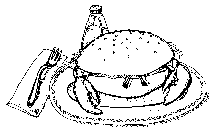|
|
 |
||||||||||
|
|||||||||||
|
|||||||||||
In Praise of Soft ShellsBringing you this Chesapeake delicacy keeps watermen up all nightby M.L. Faunce
Bob Evans doesn’t get much sleep these days. The Churchton waterman and crabber spends long days on the water checking his pots for blue crabs that he sells at his roadside store or delivers to restaurants. Sometimes, he says, he’s up all night babysitting water-fed trays of peelers or shedders. Peelers are crabs that will soon shed their shells, transforming themselves into the buttery-textured soft crabs that are a seasonal delight in the Chesapeake region and whose fame has spread worldwide, especially to Japan. In the soft-shell stage, the entire crab can be eaten. Lore has it that the first soft crabs of the season shed on the full moon in May. Shedding continues through October, as long as crabbers find peelers in the crab pots. Crabs can only grow larger by molting, and they grow by about a third with each shedding. A crab will shed seven or eight times in the first year of its life; females some 20 times in an average lifespan of three years, and males slightly more. Pulitzer Prize-winning William Warner writes in Beautiful Swimmers that crabs hatched in June reach adult size — four to five inches — by August or September of their second summer. The softshells we enjoy are reaching that stage or well beyond it. Soft crabs are graded in five sizes descending from whales, five and one-half inches and up; jumbos, five to five and a half inches; primes, four and a half to five inches; hotels, four to four and a half inches; and mediums, three and a half to four inches. For my money, softness rules over size. Having shed its shell, a soft crab begins to harden within two hours of molting. That inevitable hardening to paper-shell texture — a crab returning to its hardshell self — is why Bob Evans keeps watch at night, gently pulling the newly molted crabs out of the water, suspending the softened state through chilling. Maryland is the primary state for producing softshell blue crabs, followed by North and South Carolina and Louisiana. Maryland’s colder estuary produces a crab high in flavorful fat. Maryland’s softshells are delicious but alarming. The first time a young niece saw a soft crab at an Annapolis waterfront restaurant a few years ago, she gasped as I devoured the crisply fried creature, claws and swimmerets poking out all over from the bun in my hands. My own early experience came as a youngster spending summer days on a Patuxent River creek in St. Mary’s County. Cousin Fred and I would rise early, push off in a leaky 16-foot wooden rowboat and — using the long handle of a crabbing net — pole along the shoreline looking for crabs in the then plentiful grasses. Putting the hard shell crabs in a live box and cradling the soft shells in the shade under the bow of the boat, we’d head home long before the sun grew hot. Back at the river house, my aunt Mary dressed the soft shells, lifting the shell to snip the devil fingers, or lungs, and cutting the mouth and face behind the eyes to clean. Sensitive cooks pierce the crab between the eyes first to kill it. Maryland Department of Agriculture seafood marketer Noreen Eberly says that more than 100 years ago, watermen of historic Crisfield introduced the soft crab to the seafood industry and the world. Each season, watermen like Bob Evans, chefs, home cooks and seafood lovers continue the tradition. Prize-winning writer M.L. Faunce, of Churchton, has contributed to Bay Weekly since 1996. |
|||||||||||
|
|||||||||||
|
© COPYRIGHT 2007 by New Bay Enterprises, Inc. All rights reserved. |
|||||||||||
